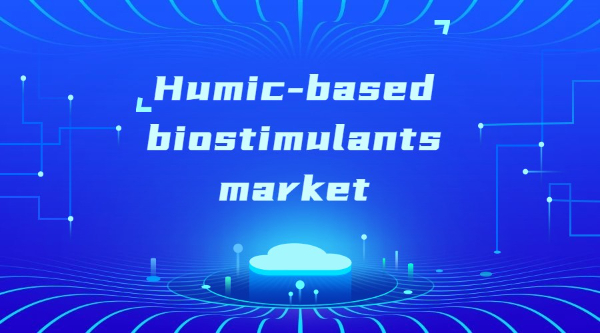
Exhibition time: 17-19 March, 2026 Shanghai, China
 中文
中文

Exhibition time: 17-19 March, 2026 Shanghai, China
 中文
中文

Latest Study on Industrial Growth of Humic-based Biostimulants Market 2023-2029. A detailed study accumulated to offer current insights about important features of the Humic-based Biostimulants Market. The report contains different market predictions related to revenue size, production, CAGR, Consumption, value chain optimization, price, and other substantial factors. While emphasizing the key driving and restraining forces for this industry, the report also offers a complete study of the future trends and developments of the market. It also examines the role of the leading corporations involved in the industry including their corporate overview, financial summary, growth rate, available market and SWOT analysis.
“The global market for humic-based biostimulants is estimated at USD 686 million in 2023; it is projected to grow at a CAGR of 11.5% to reach USD 1,184 million by 2029.”
Most Prominent Players in the Market are: FMC Corporation, UPL Ltd, Borregaard, Koppert Biological Systems, Valagro SpA, Haifa Group, Sikko International Ltd, Novihum Technologies GMBH, Humintech GMBH, Qingdao Future Group, Promisol, Bioline, Humic Growth Solutions, Actagro, Rovensa, CIFO, Loveland
This report segments the Humic-based Biostimulants Market on the basis of Types are:
Cereals
Oilseeds
Fruits & Vegetables
Fiber Crops
Others
On the basis of application, the Humic-based Biostimulants Market is segmented into:
Humic Acid
Fulvic Acid
Potassium Humate
Regional Analysis:
For comprehensive understanding of market dynamics, Humic-based Biostimulants Market is analyzed across key geographies namely: United States, China, Europe, Japan, South-east Asia, India and others. Each of these regions is analyzed based on the market research findings of key countries in these regions to understand the market on a macro level.
Humic-based Biostimulants Market Dynamics
Driver: Rise in demand for humic-based biostimulants to combat pesticide toxicity
Pesticides are chemical substances intended for preventing or controlling pests. These are toxic substances that contaminate the soil. According to the report by a Kerala non-profit Pesticide Action Network, in India, four highly hazardous pesticides, i.e., Chlorpyrifos, Fipronil, and Atrazine, are used for crops more than officially approved. The approval of pesticides is given based on their residues on crops. Humic-based biostimulants are a sustainable approach to mitigating the toxicity of pesticides. Pesticide application is needed to increase crop production. One-third of the crop yields are produced by utilizing pesticides. The after-effects of pesticides on plants are dose-dependent, causing disruption and alteration of various physiological and biological processes, ultimately reducing growth and productivity.
Restraint: Commercialization of low-quality biostimulant products by local players
The crop protection industry has been growing rapidly over the past few decades. According to a report by Phillip McDougall on the Evolution of the Crop Protection Industry since 1960, published in 2018, more than 600 active ingredients were available to farmers across the globe. The market has more than 40 chemical groups, which have different modes of action and are the key to addressing problems related to resistance to insecticides, herbicides, and fungicides and increasing yields. The growing demand among farmers for conventional pesticides has led to the steady growth of humic-based biostimulants, although there has been a decrease in the number of new chemical pesticide launches in the market. However, the preference for conventional pesticides has continued to increase as these products have a well-established market and are easily available compared to biologicals. Even though the awareness about biological crop protection has been encouraging enough in emerging economies to identify registered products and eliminate the notion among farmers that biostimulants products would be mostly counterfeit or spurious products, farmers are risk-averse to the adoption of biologicals as they are accustomed to the use of chemical pesticides due to the perception of higher yield and higher efficiency. In addition, most farmers perceive that biological crop protection products are costlier and take longer to take effect than conventional counterparts, which is a major challenge to the adoption of humic-based biostimulants.
Opportunity: Growth opportunities in developing countries
According to FAOSTAT, China, India, Brazil, and Argentina were some of the largest consumers of pesticides. The increasing rate of population, growing middle-class families, and an increase in disposable income, especially in these regions, have resulted in an increase in the demand for food, which would, in turn, lead to increased consumption of pesticides to obtain higher yields. However, the primary concerns in this region are pollution and contamination of the soil, as well as their harmful effects on the food chain. To combat the harmful effects of chemical pesticides, the governments in these regions are emphasizing the use of integrated pest management. In countries such as India and China, the average landholding of farmers is less, and the economic condition of farmers is poor. The absence of many producers in the industry and low entry barriers will give a first-mover advantage to entrants. The key players in the agricultural sector have started investing in the potential markets of emerging countries in the region. The rise in awareness among farmers about the advantages of biostimulants applications would drive its consumption in the Asia Pacific and South American regions.
Source: Digital Journal
